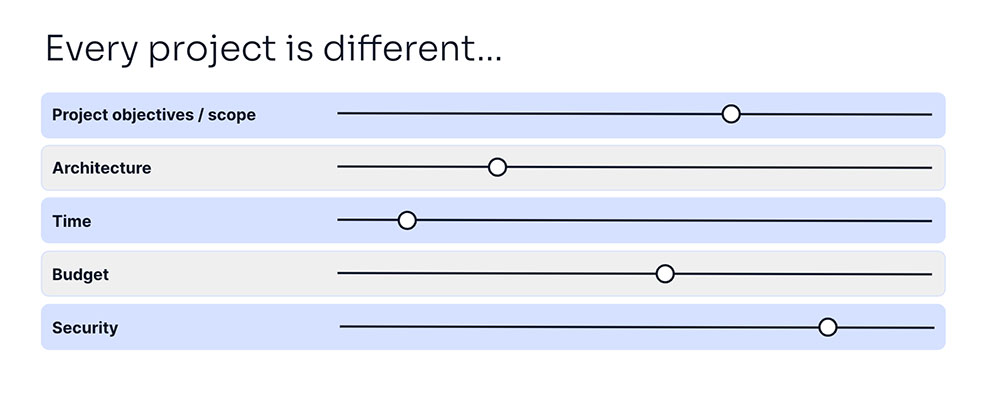Reduce Spend and Drive Efficiency Through Cloud Optimisation
If you’re a business leader, staying on top of your cloud investment is essential. Why? According to Flexera’s 2023 State of the Cloud Report, public cloud spending was over budget by an average of 18%, and respondents indicated a 39% increase YoY in the amount of cloud spend over budget. Despite this, 30% of respondents expected cloud spend to increase in the next twelve months.
Given the current economic climate, and the possibility of cloud costs increasing in the near future, few organisations can afford to be going over budget or losing track of what they’re getting from their tech spend. This is where cloud optimisation can help.
But what does cloud optimisation involve? And how do we approach it here at DiUS? Here’s everything you need to know.
How we approach cloud architecture, deployments, and cost optimisation frameworks
The approach to cloud architecture begins with understanding the customer’s needs and tailoring the solution accordingly.
Understanding our customer’s needs is the first step towards tailoring a solution to meet their requirements. This understanding requires identifying the various trade-offs and ranking them based on importance. It’s essential to have the entire team aligned from the outset to ensure a successful outcome.
One helpful technique for identifying trade-offs is using sliders, which can explicitly call out and rank various trade-offs, such as time, cost, and scope. This technique helps to get the team set from the beginning and to ensure that everyone is working towards the same goals.

Cloud maturity is also an important consideration when building a complex solution. Determining maturity involves looking at factors such as the availability of a strong cloud team to maintain the platform and the company’s risk appetite, particularly in regulated industries.
Different companies have different requirements and motivations, such as startups needing to move quickly to generate revenue, while enterprises tend to be more conservative and have a risk-averse perspective. Ensuring it meets the organisation’s needs is essential when designing a cloud architecture.
Designing cloud architecture for optimisation.
When designing cloud architecture, cloud providers have guidelines on best practices for using the cloud.
For example, Amazon has the Well-Architected Framework, which includes five pillars:
- Operational excellence – using tools and techniques to ensure the system is continually delivering business value and there are ways to improve processes continually
- Security – protecting data and reducing system risks
- Reliability – ensuring the system can scale up and down on demand and navigate unanticipated system disruptions
- Performance – ensuring the resources used by the system are appropriate (e.g. right-sizing) and the system performs efficiently
- Cost – optimising the ratio of business value to cost
- Sustainability – minimising the environment impacts of running cloud workloads and maximising utilisation
These pillars provide a comprehensive approach to designing cloud-first architectures that are efficient, secure, and cost-effective.
How to analyse the total cost of cloud ownership for better cost optimisation.
Any solution proposed has a positive Return On Investment (ROI) attached to it.
Determining ROI requires a Total Cost of Ownership (TCO) analysis to view the predicted performance of new investments and review the performance of historical investments.
One of our previous webinars provides hypothetical scenarios to help you look at the various angles of cloud cost investment which we recommend you check out here.
Example: Internal Platform v Platform as a Service –
Compare the cost analysis of building an in-house platform versus using a platform as a service offering.


Imagine your team needs to get a new product to market quickly – A digital version of your signature fidget spinner product.
The team has two options: build an internal platform or use a Platform as a Service (PaaS) offering like Beanstalk or Heroku. The example compares the total cost of ownership of both options over three years, assuming a 5% monthly growth in usage. The TCO analysis considers the cost of delay, labour costs, monthly bills, and maintenance/upkeep costs.
The analysis shows that even though the monthly running costs are significantly higher for the platform as a service option, the total cost of ownership is much lower because of the lower initial price and ongoing maintenance costs.
Example: Cloud Migration for a Retailer –
Discuss the importance of considering the total cost of ownership when deciding whether to use a serverless computing model versus a traditional one.
A large retailer has migrated to the cloud to improve customer experience and operations. The retailer has multiple applications and databases that need migration.
The importance of conducting a comprehensive assessment of existing systems, determining the right migration strategy (rehost, refactor, revise, rebuild, or replace), setting realistic migration timelines and goals, and building a solid migration team with the necessary skills and expertise is crucial before making any cloud investment.
Larger organisations with many teams and products tend to lean toward platforms because they have more to gain relative to costs. The opposite is generally true for smaller organisations.
You can use this analysis to forward new projects and look back on existing platforms.
Our webinar also covered the topics of fundamental hygiene aspects for operating effectively at scale and provided detailed techniques to reduce bills immediately, which you can watch here or explore these topics in our secondary article.
Reviewing your architecture, cloud infrastructure setup, and delivery practices is essential to drive optimum efficiency and reduce spending on your cloud technology.
Want to know more?
You can book an assessment with our consultants where we will assess your cloud environment and provide an optimum pathway to cloud optimisation, which will help you to:
- Deliver essential cost savings now and boost operational agility well into the future
- Reduce complexity, streamline and automate processes for continuous optimisation.
- Gain control of their current cloud accounts for future deployments.
- Understand what services they are using and how they are using them.
Contact us to book or find out more.

